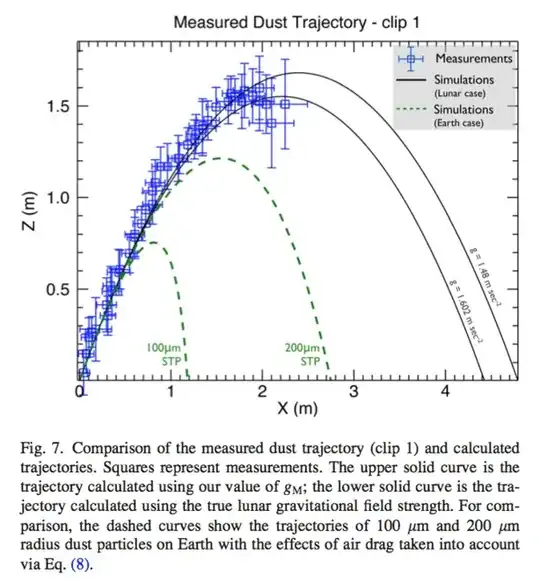
This graph shows the observed trajectory of lunar rover dust particles is roughly the same as in a simulated earth case. However, the earth has 6 times more gravity. Is this an accurate graph?

This graph shows the observed trajectory of lunar rover dust particles is roughly the same as in a simulated earth case. However, the earth has 6 times more gravity. Is this an accurate graph?
I traced the graph to this paper by Hsiang-Wen Hsu and Hsiang-Wen Hsua at University of Colorado Boulder. It was published in 2012 in American Journal of Physics.
The paper is behind a paywall so I can not link to it, but I read it and it appears correct.
The authors watched video from the Apollo Moon walks looking for certain frames in which dust was kicked up by the buggy. Using those frames they measured how high and how far the dust went - that's the blue squares on the plot. This is possible because they know the frame rate and resolution of the video footage. Using the wheel of the rover as an yard stick (16 inch wheel), they can convert pixel sized to meters. Time is also know from the frame rate.
Using ballistic motion equations and accounting for linear drag they calculated 4 trajectories - 2 with Earth gravity (green dashed lines), 1 dust trajectory from the data they extracted from the video and 1 expected Moon trajectory using the actual moon gravitational constant.
Here is the paper's summary:
We have analyzed the motion of the dust clouds lofted by the Lunar Roving Vehicle of the Apollo 16 mission. Adopting a simple 2D geometry, we found that the dust followed ballistic trajectories under the influence of the lunar gravity. The gravitational constant of the moon derived from the dust trajectory is within 10% of the expected value. The images used in our analysis are available online for use as supplementary material in physics education.